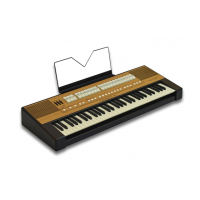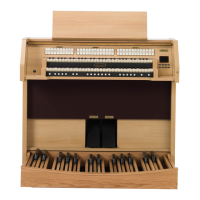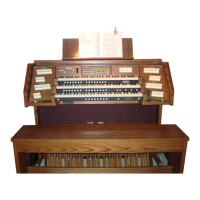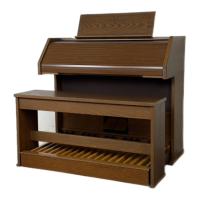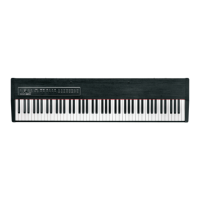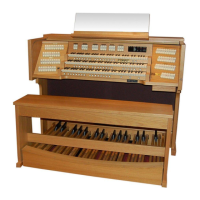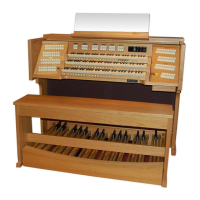Do you have a question about the Viscount Cantorum Duo Plus and is the answer not in the manual?
Essential safety precautions for operating the organ, including electrical shock prevention and proper usage.
Guidelines for maintaining and protecting the organ from damage and environmental factors.
Notes on the manual's content, usage, copyright, and manufacturer's rights for product modifications.
Detailed description and identification of the organ's front panel components and their functions.
Explanation of the various thumb pistons for controlling orchestral voices, couplers, and combinations.
Overview of the rear panel connectors for headphones, audio input/output, MIDI, and power.
How to display and navigate through the instrument's main video page and its parameters.
Accessing and understanding the different sections within the instrument's main menu.
Information on what a Pipe Set contains and the procedure for selecting one.
Functions for copying, renaming, and restoring Pipe Sets to their default configurations.
Procedures for exporting and importing combinations to/from a USB flash drive.
How to reset all organ combinations, Crescendo steps, and Tutti to factory settings.
Setting the overall organ volume and individual divisional volumes for internal and external amplification.
Adjusting the instrument's transposition, fine-tuning pitch, and selecting temperaments.
Configuring tremulant effects and fine-tuning air pressure simulation for sound realism.
Setting individual stop parameters like volume, attack, tremulant type, and character.
Customizing the stereophonic reproduction (panning) of voices through internal channels.
Selecting and adjusting parameters for orchestral voices, including split and layer types.
Configuring key velocity response and simulating tracker touch feel for manuals and pedalboard.
Enabling the Short Octave feature and selecting operating modes for the Auto Pedal function.
Setting expression pedal assignments and swellbox step configurations for organ divisions.
Enabling/disabling the saving of couplers, tremulants, expression pedals, and orchestral voices in combinations.
Adjusting the internal reverberation effect, including style, early reflections, and reverb tail.
Adjusting the five-band equalizer for the organ's internal amplification.
Regulating volumes of external outputs and routing audio inputs to outputs.
Selecting input and output MIDI channels for each organ section (Pedal, Manual I, Manual II).
Configuring filters to block specific MIDI messages like Control Change or Program Change.
Saving Program Change and Bank Select messages within combinations for external sound module control.
Overview of what a Snapshot backup file contains, including Pipe Sets, combinations, and settings.
Procedures for saving the entire organ configuration to a USB drive and loading it back.
Restoring the organ's entire configuration or just its settings to factory default states.
Instructions for updating the organ's operating system via a USB flash drive.
Locking specific organ settings, combinations, or sequencer functions with a password.
Calibrating expression and crescendo pedals and setting operating modes for pedals and MIDI pedalboards.
How to play back saved songs and record new performances using the internal sequencer.
Adding new recordings to existing MIDI tracks, preserving or replacing original settings.
Creating, editing, and managing lists of MIDI songs for playback.
Configuring playback options like transposition and looping, and deleting songs or lists.
Setting stops to Local Off mode to transmit MIDI messages without internal sound generation.
Explanations of common on-screen error messages and troubleshooting guidance.
Detailed descriptions and explanations of various tuning temperaments available on the organ.
Descriptions of different simulated windchest types for pipe organ sound realism.
Basic explanation of MIDI interface, messages, and communication protocols.
Essential safety precautions for operating the organ, including electrical shock prevention and proper usage.
Guidelines for maintaining and protecting the organ from damage and environmental factors.
Notes on the manual's content, usage, copyright, and manufacturer's rights for product modifications.
Detailed description and identification of the organ's front panel components and their functions.
Explanation of the various thumb pistons for controlling orchestral voices, couplers, and combinations.
Overview of the rear panel connectors for headphones, audio input/output, MIDI, and power.
How to display and navigate through the instrument's main video page and its parameters.
Accessing and understanding the different sections within the instrument's main menu.
Information on what a Pipe Set contains and the procedure for selecting one.
Functions for copying, renaming, and restoring Pipe Sets to their default configurations.
Procedures for exporting and importing combinations to/from a USB flash drive.
How to reset all organ combinations, Crescendo steps, and Tutti to factory settings.
Setting the overall organ volume and individual divisional volumes for internal and external amplification.
Adjusting the instrument's transposition, fine-tuning pitch, and selecting temperaments.
Configuring tremulant effects and fine-tuning air pressure simulation for sound realism.
Setting individual stop parameters like volume, attack, tremulant type, and character.
Customizing the stereophonic reproduction (panning) of voices through internal channels.
Selecting and adjusting parameters for orchestral voices, including split and layer types.
Configuring key velocity response and simulating tracker touch feel for manuals and pedalboard.
Enabling the Short Octave feature and selecting operating modes for the Auto Pedal function.
Setting expression pedal assignments and swellbox step configurations for organ divisions.
Enabling/disabling the saving of couplers, tremulants, expression pedals, and orchestral voices in combinations.
Adjusting the internal reverberation effect, including style, early reflections, and reverb tail.
Adjusting the five-band equalizer for the organ's internal amplification.
Regulating volumes of external outputs and routing audio inputs to outputs.
Selecting input and output MIDI channels for each organ section (Pedal, Manual I, Manual II).
Configuring filters to block specific MIDI messages like Control Change or Program Change.
Saving Program Change and Bank Select messages within combinations for external sound module control.
Overview of what a Snapshot backup file contains, including Pipe Sets, combinations, and settings.
Procedures for saving the entire organ configuration to a USB drive and loading it back.
Restoring the organ's entire configuration or just its settings to factory default states.
Instructions for updating the organ's operating system via a USB flash drive.
Locking specific organ settings, combinations, or sequencer functions with a password.
Calibrating expression and crescendo pedals and setting operating modes for pedals and MIDI pedalboards.
How to play back saved songs and record new performances using the internal sequencer.
Adding new recordings to existing MIDI tracks, preserving or replacing original settings.
Creating, editing, and managing lists of MIDI songs for playback.
Configuring playback options like transposition and looping, and deleting songs or lists.
Setting stops to Local Off mode to transmit MIDI messages without internal sound generation.
Explanations of common on-screen error messages and troubleshooting guidance.
Detailed descriptions and explanations of various tuning temperaments available on the organ.
Descriptions of different simulated windchest types for pipe organ sound realism.
Basic explanation of MIDI interface, messages, and communication protocols.
| Brand | Viscount |
|---|---|
| Model | Cantorum Duo Plus |
| Category | Musical Instrument |
| Language | English |
